We arrived at Puerto Varas, avoiding Puerto Montt as guide books were not very flattering about the other city in the region, in mid-afternoon. In many ways Puerto Varas is similar to Pucon: it has volcanos (3 or 4 visible on a clear day), it is on the edge of a lake and it is also a popular tourist destination. However, I would describe Pucon as being a little more ‘up-market’, but Puerto Varas is a larger city and probably has more to offer. We had decided to spend 2 nights there.
We checked in to the Licarayen hotel. Once again we were concerned about finding vacancies and this hotel had had good reviews so were pleased to find availability. However, we found it a little simple and nothing special. Breakfast was again particularly uninspiring with instant coffee and a very limited selection. I think we could have found something better, but it was close to a beach and the town centre.
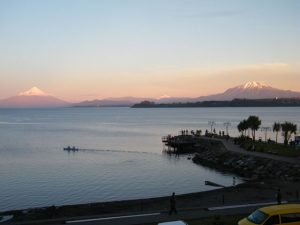
On the day we arrived, there was beautiful sunshine which allowed for some good shots of the Osorno volcano (the closest to the city). The above was taken on our first night. The next morning, however, we awoke to fog with extremely limited visibility and no volcanos to be seen! We were a little tired anyway, so took it easy in the hotel in the morning, but when the cloud started to lift we decided to drive around the lake to get closer to the mountains as Puerto Varas itself is quite flat and not terribly beautiful.
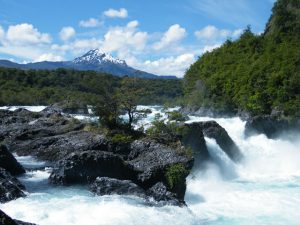
The drive to Petrohue from the centre of the town was only about 50 km. The first half is flat and fairly unspectacular, but the last section is beautiful. Fortunately, as we drove the clouds continued to lift. About 5 km short of Petrohue the paved road runs out at Salto del Petrohue. Here there are a number of cataracts and falls, even though they are not particularly high the volume and proximity to the water makes them impressive.
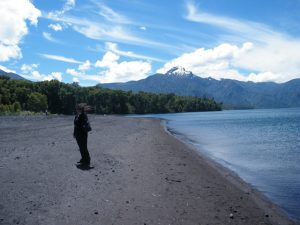
If you carry on along the road you come to Petrohue where you can catch a ferry to take you to Peulla and cross the Andes to Bariloche in Argentina. This would be a beautiful trip, and one I would like to do, but we didn’t have time this trip. Maybe one day we will make it in the reverse direction from Bariloche. Despite not being able to make the crossing, we still found Petrohue to be very beautiful being on the edge of lake, close to Osorno volcano and the source of the Petrohue river that flows over the falls mentioned above. There are places to stay if you want. It is also possible to take a day trip to Peulla by boat from Petrohue, but as we arrived in the afternoon, it was also too late to do this.
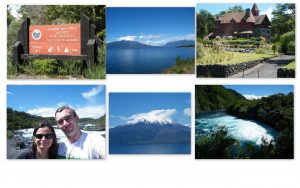 The next morning, we left Puerto Varas to start the long (~1000 km) drive back to Santiago. We decided to stop twice en-route. The first would ideally have been around half-way, but we couldn’t find anything that looked interesting in our guide book so elected to stay in the city of Valdivia which is described as ‘cosmopolitan’.
The next morning, we left Puerto Varas to start the long (~1000 km) drive back to Santiago. We decided to stop twice en-route. The first would ideally have been around half-way, but we couldn’t find anything that looked interesting in our guide book so elected to stay in the city of Valdivia which is described as ‘cosmopolitan’.
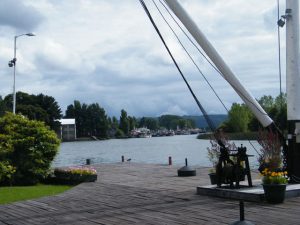
It was a relatively short drive of just over 200 km up the main highway with a 50km turning to the left (west) towards the coast. We mistakenly thought we would see the Pacific Ocean and a proper beach, but alas no! As for cosmopolitan, the only evidence we discovered for this was a Macdonalds and a Chinese restaurant. To say we were disappointed is a total understatement. The pictures may paint a pretty picture, but most of the town was very very different.
We stayed at the Naguilan hotel. The hotel was again clean and comfortable with a slightly better breakfast than a lot of the other hotels, but it was a 20 minute walk from the town centre and located in a poor neighbourhood with a dock for fishing boats a short distance away. Whilst I wouldn’t say don’t stay here as the grounds and hotel are pretty, there is a modern and what appears from the outside to be a much better located hotel in the city centre.
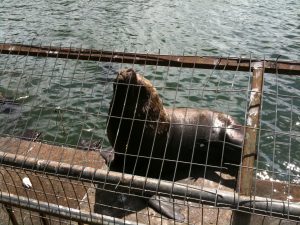
The only other thing apart from an old submarine of indeterminate age and origin that I found interesting in Valdivia was a group of Elephant seals/Sea lions (I don’t know which) that played in the river close to a fish market and hauled themselves out of the river to bask in the sunshine.

Chegamos em Puerto Varas e nos instalamos no Hotel Licarayén, num quarto com frente para o Lago Llanquihue e uma vista dos vulcões Osorno e Calbuco de tirar o fôlego. Nem chegamos a ir a Puerto Montt, já que tínhamos ouvido, mais de uma vez, que não valia a pena esticar a viagem até lá.
Puerto Varas é uma cidade parecida com Pucón, com lagos e vulcões e muitos turistas que aproveitam da infraestrutura da cidade para fazer base e explorar o entorno. O parque nacional Vicente Perez Rosales fica bem próximo, e aí é possível fazer trilhas, caminhadas, e até mesmo escalar o vulcão Osorno.
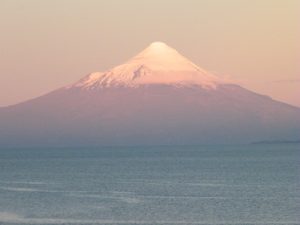
Queríamos ver o Lago de Todos os Santos, de onde começa a travessia para Bariloche, que eu tinha feito há muitos anos, e para lá fomos na tarde seguinte. A estrada vai margeando o lago Llanquihue por uns 40 km, até Ensenada. Daí a paisagem se torna mais bonita, principalmente quando a estrada se encontra com o Rio Petrohué, o rio mais turquesa que já vi. Paramos para ver as corredeiras, chamadas Saltos de Petrohué, logo antes da entrada do Parque Nacional.
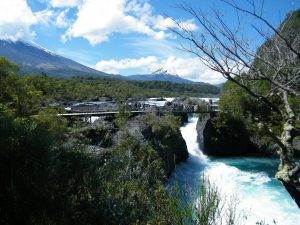
Seguindo por uma estradinha de terra de 6 km chega-se ao ponto final para quem não vai pegar o ferry boat para Peulla e seguir até a Argentina. É o Lago de Todos os Santos, o mais bonito que vimos na região. É chamado de Lago Esmeralda justamente por causa da cor intensa da água. As margens do lago são de uma areia escura, que nos pareceu resultante de uma erupção vulcânica passada.
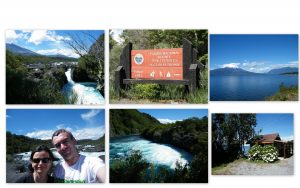
Resolvemos que vamos voltar um dia para fazer a Cruce de Lagos, e completar o passeio que começa aqui em Petrohué. Por ora, tínhamos de voltar a Puerto Varas, para começar, no dia seguinte, nossa viagem de volta a Santiago. Neste trecho iríamos parar em Valdívia, uma cidade que, segundo nosso guia de viagem, compensava o desvio de 50 km a oeste da Ruta 5. Queríamos também ver o Oceano Pacífico, e achamos que esta cidadezinha litorânea seria uma boa pedida. Segundo a descrição do guia, era uma cidade cosmopolita, vibrante, que mistura o colonial com o contemporâneo.
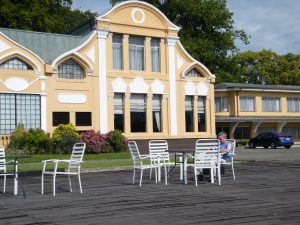
Logo descobrimos que, na verdade, Valdívia não fica no litoral, mas em uma confluência de rios a alguns poucos quilômetros do mar. A cidade também não é tão cosmopolita quanto descreveu nosso guia, mas é uma pequena cidade universitária, que abriga o campus da Universidade Austral do Chile. Como era um período de férias, não havia muito movimento. Gostamos muito do hotel em que ficamos, o Hotel Naguilán, um pouco afastado do centro, mas com um delicioso deque para o Rio Valdívia.
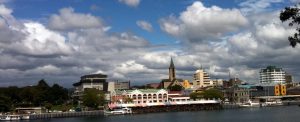
A cidade tem um Mercado Fluvial e, na ilha logo em frente, um Museu Histórico e Antropológico. Há vários barcos ancorados, que fazem passeios pelos rios da região, e levam a algumas fortificações espanholas do século XVII. Nos contentamos em ver os leões marinhos, que aparecem no rio próximo ao mercado para ganhar restos de peixe e tomar um banho de sol. Havia também um misterioso submarino ancorado que, pareceu ao Steve, ser da Segunda guerra mundial.

Para não encarar os 850 km até Santiago, decidimos dormir próximo a San Fernando, e aproveitar nossa última noite novamente no Vale do Colchagua. Minha vontade era ficar no hotel da vinícola Casa Silva, mas estava lotado. Reservamos então uma noite na Hacienda Los Lingues, “uma das haciendas mais antigas e bem preservadas do Chile”, segundo nosso guia. Mas esta história fica para a próxima…
Mais da nossa viagem ao Chile:
Para ver mais fotos, clique aqui.
Para ler o relato do Steve, selecione o idioma inglês.
Leave a Reply